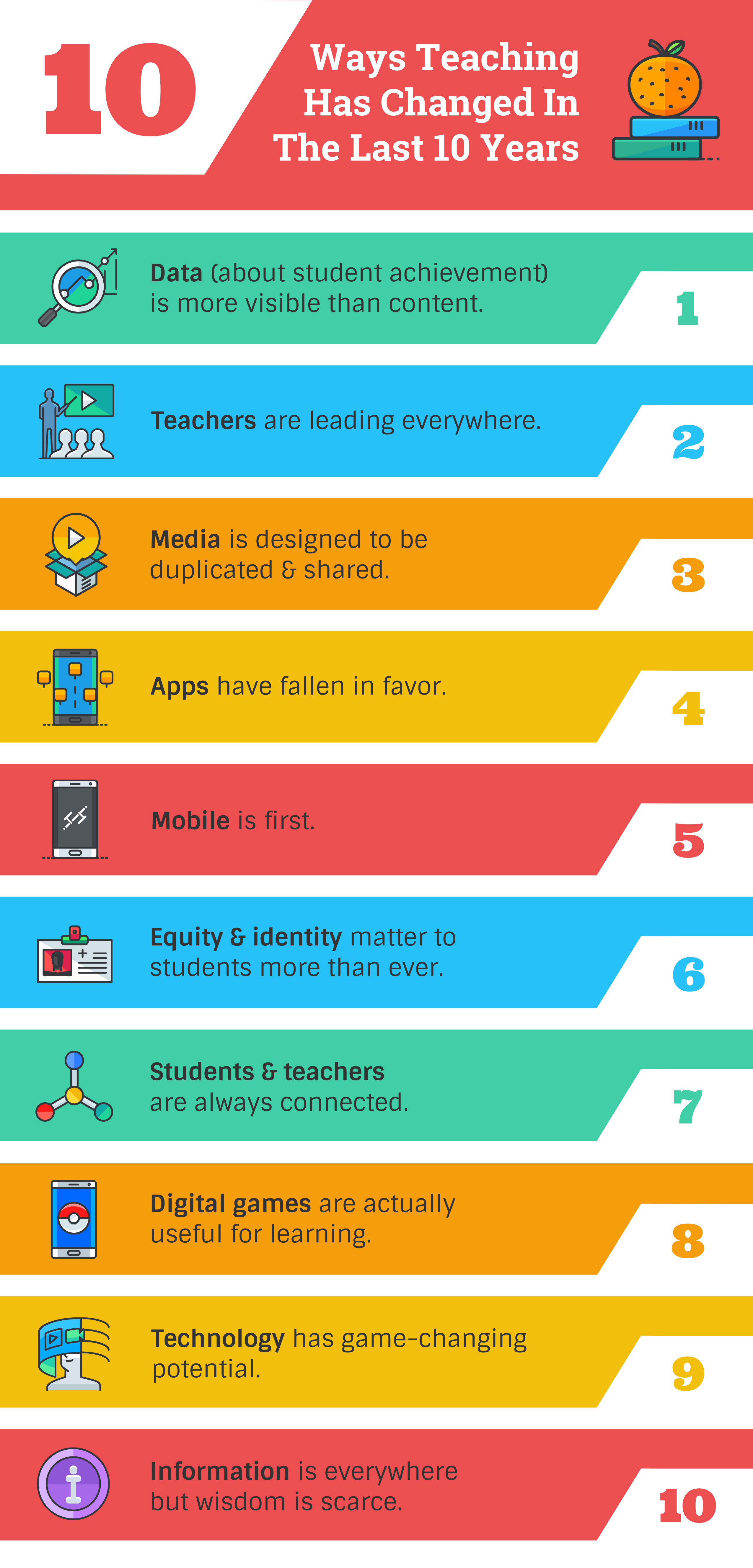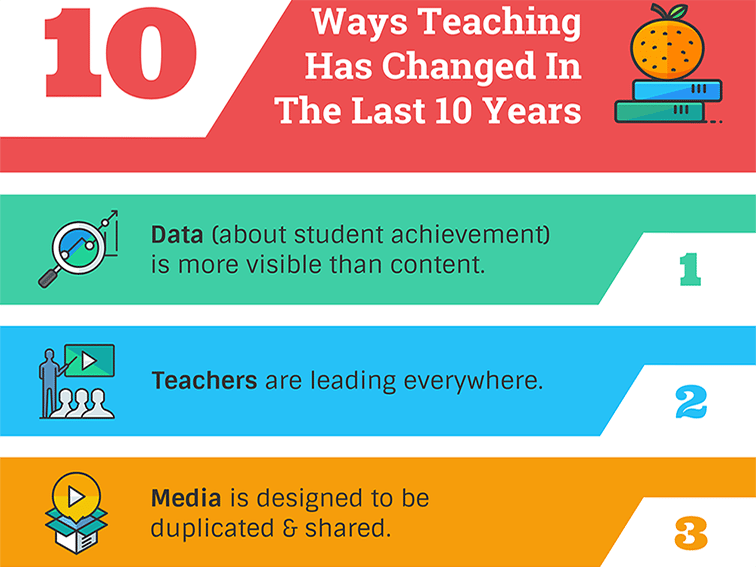How Has Teaching Changed In The Last 10 Years?
by Terry Heick
Teachers are the arbitrators of knowledge and culture.
Knowledge and culture are each dynamic, endlessly crashing and churning. This makes teaching significantly important and difficult work and can leave teaching—as a craft—wide-eyed in response.
Worse, those outside the bubble of education can understandably struggle to understand the problem. What are they teaching in those schools anyway? How is it any different from when I was in school? Well, as it turns out, much of it is different from even five years ago.
Starting with literacy.

10 Ways Teaching Has Changed In The Last 10 Years
1. eLearning is central to most academic programs
Whether your classroom is remote teaching and learning, virtual, blended, or brick-and-mortar only, eLearning is no longer about MOOCs and Googling questions. Rather, without quality eLearning to supplement the classroom–in a flipped, blended model, for example–the learning feels unplugged. And further, requires the teacher to reconcile the plugged in with the unplugged experiences.
Privacy, data collection, results reporting, social learning, and more are all very different online and off. One isn’t necessarily better than the other, but if they’re not designed to work together at a curriculum-level, the teacher is required make it all work–for every child. Every day. That’s not just impossible, it can shorten teaching careers and limit the access (by students) to quality learning experiences.
2. Teachers are leading everywhere.
While teachers have always led, historically teachers have ‘shown leadership’ within a classroom and, at times, in schools and even districts. Today, teachers are leading through teacherpreneurship–disrupting how teaching materials are created and sold, sharing ideas and encouragement on social media, and connecting directly with students and communities in countless ways.
Teachers are, increasingly, teaching disruptively.
3. Media is designed to be duplicated & shared
Here’s why this matters: Digital devices have changed everything. They promote personalization, offer direct access to everything, support the mashing of media, are interactive, and mobile. While education isn’t close to figuring out that last part, the first four are giving it plenty to work on in the meantime.
If literacy is understanding how to read and write, then anything read or written/created digitally is first and foremost about reading and writing, but with unique nuance. Socializing ideas, multimodalities, complex methods of tagging and curating, endless acronyms and initialisms, fluid transfer from one form (a tweet) to another (a YouTube video) to another (a YouTube video tweeted) to another (a shorter gif version of that video then pinned on pinterest) to another (ultimately arriving as a meme that is then shared on Instagram).
This is a pretty big deal, and requires the deft hand of teachers to make the adjustments.
4. Apps have fallen in favor
Many teachers have either given up on apps or shifted their use to something more intermittent and isolated than clean-sheet-redesign/apps-are-the-new-textbooks. 10 years ago, this is not the future many predicted.
5. Mobility matters.
But even as apps have fallen in favor, mobility is the new standard. Information, communication, search, purchasing, identity—mobility matters in the modern world.
And mobile learning is also a thing. Students can get up from their desks and walk around now in ways that enable learning–and not just field trips. This happened ten years ago, of course. And 50 years ago. But the further we get into the 21-st century, the more–in a progressive learning environment–they have a need to do so. That is, the learning may work less well if it’s not somehow mobile.
This requires self-monitoring strategies on the part of students to make it work. But if they can manage, they can review content and use second (or third) screens, connect with experts, Skype with other classrooms, engage in school-to-school collaboration for project-based learning, and participate in experiential learning in authentic local communities. This is far less possible without attention to elements and principles of mobile learning.
It is easy to miss what a dramatic change this represents for education. Note, this doesn’t mean that all teaching is mobile (here are some examples of mobile teaching) but rather that teaching and learning that aren’t at least ‘accessible’ on laptops, tablets, or other mobile devices is increasingly rare.
6. Equity & identity matter to students more than ever
Equity is more and more an issue a decade and a half into the 21st century. In the 1990s, profits, corporate greed, and systematic policies were less visible—niche. The occupy wall street movement changed that, and the Millennials have taken up that mantle as a significant theme for their generation.
Access to technology, socioeconomic issues, language barriers, culturally indifferent standardized assessment, WiFi speeds, and dozens of other issues are no longer niche side-conversations, but rather central issues teachers have to confront in both curriculum, instruction, and community engagement. Content holding and distribution—if it was ever—is no longer enough.
Teachers are both diplomats of often very bad school policies, and ombudsman for students and families.
7. Students & teachers are always connected
Teachers are expected to both learn, plan, publish, share, and collaborate endlessly with other teachers, and then support their students to do the same with their own peers.
The first step here is to help students to identify potential collaborators—often in other countries that speak other languages. I didn’t teach in 1953, but I’m guessing this wasn’t common.
8. Digital games are actually useful for learning.
They’re one of the best ways to review content, for example. Imagine how odd this would’ve seemed 25 years ago.
9. Technology has game-changing potential
A sleeping giant in education (well, besides parents) is adaptive software. This is the killer app for education as it struggles to make sense of a new world and new expectations.
Apps are now available that adapt to student performance in a way that teachers can’t. Yes, they can and will replace teachers for many of the skill-based tasks that can be automated without losing their efficacy.
And in education that depends on curriculum as we know it, there are many of these.
10. Information is everywhere but wisdom is scarce
Try convincing a student to listen to you explain how Europeans came to America for religious freedom when they can Google that tidbit in 45 seconds, then access an entire YouTube channel dedicated to that very idea while surveying an edX course from an Oxford professor on the very same thing.
In the 21st-century, teachers have to respond to this while serving educational institutions that continue to operate blissfully unaware of it all. And since it’s hard to serve two masters, what do you do?
Do what you’re told in the classroom, then read this kind of stuff for fun?
Bonus
11. Data (about student achievement, for example) is more visible than content.
How true this is depends on your perspective, but the idea here is that in many schools and classrooms, teachers work in teams and departments to scrutinize assessment data rather than content or curiosity or questions or research or critical thinking or any of the other tenets of intellectualism.
More and more, schools are machines intended to produce proficiency of academic standards and when they vary from this routine, they do so outside of the design of that machine. That is, they ‘ad lib’ to add programs and related efforts to address something beyond standards-based proficiency.

